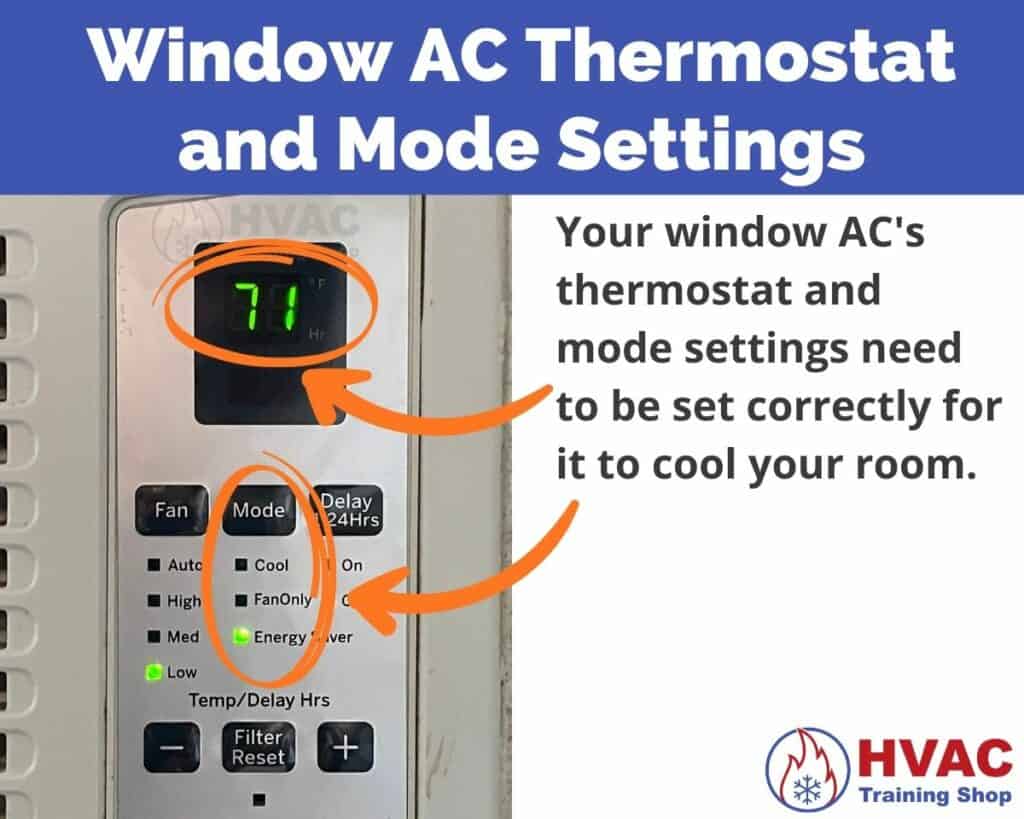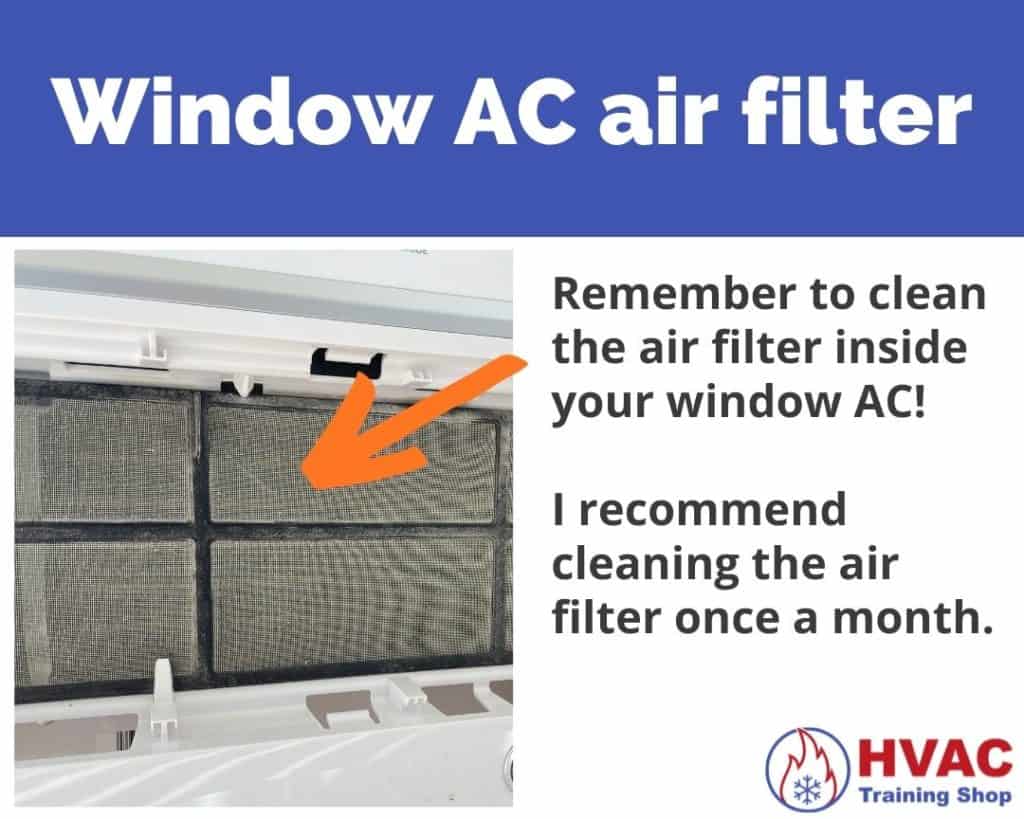Did your window AC suddenly stop cooling? Hot temperatures in your home can become unbearable pretty quickly.
So how do you fix your window AC? It could be due to many things.
In this article, I’ll go over all the reasons why your window AC isn’t cooling. I’ll also let you know what you need to do to fix your window AC and get your room cool again!
Check the Window AC’s Thermostat and Mode Settings
Your window AC won’t cool your room if its thermostat setpoint temperature and mode are not set correctly.
First, the temperature setting on the thermostat must be set to a lower temperature than your room’s temperature.
For example, if your room is 80°F then you could set the thermostat to 72°F. Setting the thermostat to a lower temperature lets the AC know that it needs to cool your space.
Another thing to check is the mode setting on your window AC.
There are two different settings that you can use for your window AC to cool your room:
- Cool Mode
- Auto or Energy Saver Mode
I’ll explain them below.
Cool Mode
If you only need your window AC to cool your room, set it to cool mode.
When your window AC is in cool mode, it knows that your intent is to cool your room.
In cool mode, your window AC will cool your room until it reaches the temperature that you set on the thermostat. After your room reaches the setpoint temperature set on the thermostat, your window AC will turn off.
Auto or Energy Saver Mode
If you’re concerned about energy efficiency, then auto mode is a better option for your window AC mode setting.
When your window AC is in auto mode (also called energy saver mode), it will find the best settings to maintain your room at whatever temperature you set on the thermostat.
When in auto mode, your window AC will cycle on and off and adjust its fan speed to deliver the right amount of cooling for the situation.

Clean the Window AC’s Air Filter
Did you know that your window AC has an air filter? Many people don’t!
A dirty air filter is one of the most common reasons why a window AC doesn’t cool a room.
When your window AC’s air filter is dirty, it inhibits airflow through your window AC. The airflow restriction makes your window AC work harder to cool your room.
To clean your window AC’s air filter, open the large plastic grille on the front of your window AC and remove the air filter.
Next, spray the air filter with water – a sprayer from the kitchen sink or shower works great for this purpose. Spray the backside of the air filter, that way the dust gets dislodged through the front of the filter.
If your air filter is really dirty, then you can use a soapy water solution to clean the excess grime off the filter. A toothbrush also works well to scrub the nooks and crannies on the filter.
After cleaning your air filter, rinse it out with water and set it out to dry. Allow the filter to completely dry before reinstalling it into the AC.
One more thing – before you reinstall the air filter in your window AC, take a look at the evaporator coil directly behind the air filter. Is it dirty?
The dust and grime from dirty air filters can sometimes pass through and get trapped in the evaporator coil as well.
If your window AC’s evaporator coil is dirty, read the next section below.
Clean the Evaporator Coil
Your window AC’s evaporator coil plays a critical role in the cooling process – it’s the part that gets cold.
The evaporator coil is located inside the window AC, right behind the air filter.
The evaporator coil absorbs heat from your room’s air to cool it down.
Over time, dust, dirt, and other debris can build up on the window AC’s evaporator coil, inhibiting its ability to cool your room.
A dirty evaporator coil can also lead to increased energy consumption. A window AC with a dirty evaporator coil has to work harder to cool your space, so it consumes more energy, leading to higher electricity bills.
Clean the Condenser Coil
A dirty condenser coil can significantly reduce your window AC’s performance and cooling efficiency.
The condenser coil is a part in your window AC that sticks outside and is responsible for dissipating heat extracted from your room to the outside environment.
If the condenser coil is coated in dirt, dust, or debris, it can’t transfer heat as effectively and won’t cool your room.
Since the condenser coil is outside, it’s extremely prone to getting dirty – so it’s very susceptible to impacting your window AC’s performance.
Furthermore, a dirty condenser coil forces your AC to work harder to maintain the desired temperature, leading to increased energy consumption and wear on your AC’s components.
Fortunately, cleaning your window AC’s condenser coil is something that you can do yourself. You don’t even need to remove the AC from the window.
I’ve written a guide on how to clean your window AC without removing it. It details the process of cleaning its condenser coil, so I recommend checking that out below.
Check if Your Window AC Has a Refrigerant Leak
If your evaporator and condenser coils are clean but your window AC is still not making air that’s cold enough, then your window AC may have a refrigerant leak.
If your window AC has a refrigerant leak, then it will only be able to cool your room at a reduced capacity. Once all the refrigerant leaks out, then your window AC won’t cool at all.
Unfortunately, there is no DIY way to fix a refrigerant leak in a window AC. You’re better off calling an HVAC professional to diagnose the issue.
Even then, it’s often cheaper to just replace the entire window AC unit instead of paying someone to fix a refrigerant leak.
Check if Your Window AC Is Undersized
An undersized window AC won’t have enough capacity to remove heat effectively. Simply put, an undersized window AC won’t keep up with cooling your room.
In some cases, the AC is too small to begin with. Or maybe it’s just a hot day.
So how do you know if your window AC is undersized?
While there are some advanced formulas and load calculations to figure out the exact cooling capacity for your space, a quick way to tell is to just check if your window AC is blowing cold.
If your window AC is blowing cold just fine, then it might be undersized for your space. Upgrading to a larger window AC unit might be the next best option.
But before you rip out your window AC and replace it with a larger one, here are some things to try:
- Shut your windows and doors to prevent warm air from getting into your room
- Use blinds or curtains to block sunlight from getting into your room
- Adjust the vents on the window AC to disperse air throughout your room more efficiently
- Use a fan to circulate the cool air throughout your room
If all that fails, then your window AC might be undersized for your space.
Consider replacing your window AC with one that’s slightly bigger to make up for the larger heat load in your space.
Check if Your Window AC Is Frozen
An often-overlooked issue that can cause your window AC to stop cooling is a frozen evaporator coil.
When an evaporator coil freezes, a layer of ice forms on the coil’s surface, which can significantly inhibit the window AC’s ability to cool your room.
So how does a window AC evaporator coil become frozen in the first place?
Here are some causes of a frozen evaporator coil in a window AC:
- Low Airflow: A dirty air filter can restrict airflow through the coil, causing it to freeze.
- Low Refrigerant Levels: If the refrigerant level is too low (usually due to a leak), it can lower the refrigerant pressure in the system and cause the evaporator coil to freeze up.
So what do you do when you find that your window AC is frozen?
I’ll go over that in my article below:




